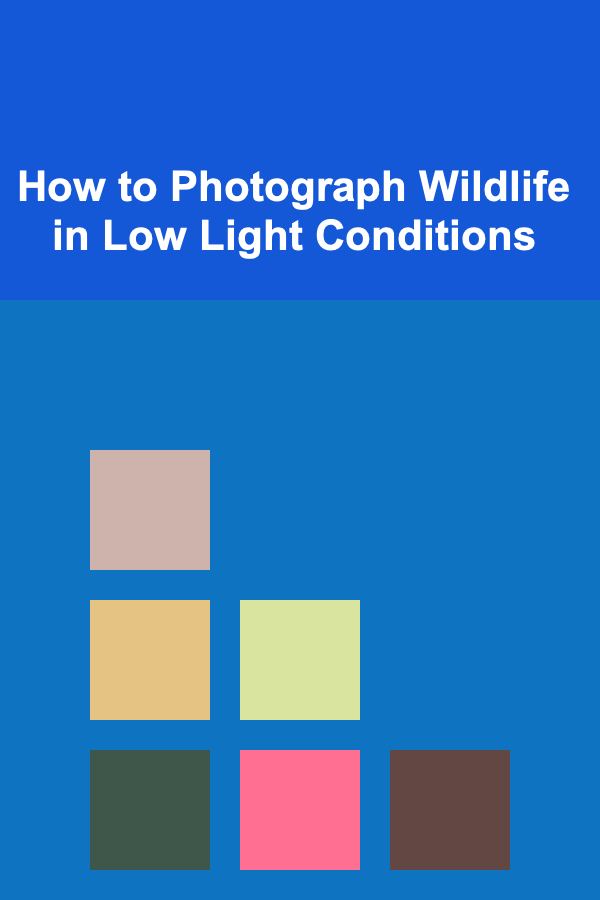
How to Photograph Wildlife in Low Light Conditions
ebook include PDF & Audio bundle (Micro Guide)
$12.99$10.99
Limited Time Offer! Order within the next:

Wildlife photography can be one of the most rewarding yet challenging pursuits for a photographer. Capturing animals in their natural habitat involves patience, a deep understanding of the behavior of the subjects, and a great deal of technical skill. Among the various challenges a wildlife photographer faces, low light conditions present some of the toughest obstacles to overcome.
Low light environments, such as early mornings, late afternoons, overcast days, or dense forests, can significantly affect the quality of wildlife images. However, with the right tools, techniques, and preparation, you can take stunning wildlife photographs in even the most challenging light conditions.
In this comprehensive guide, we will explore essential techniques for wildlife photography in low light, covering everything from gear selection and settings to practical tips that help capture sharp, detailed images despite the challenges posed by dim conditions.
Understanding Low Light in Wildlife Photography
Before diving into the specific techniques, it's essential to understand what low light conditions mean in photography. Low light occurs when there is insufficient natural or artificial light to properly expose an image without relying heavily on artificial lighting, which is often impractical in wildlife photography.
Low light conditions can present various challenges, such as:
- Slow Shutter Speeds: To capture more light, you may need to use slower shutter speeds, which can result in motion blur if the subject is moving.
- Higher ISO Values: Increasing the ISO to compensate for low light can introduce noise or grain into the image, reducing image quality.
- Limited Depth of Field: Using wider apertures (lower f-stop values) to gather more light results in a shallow depth of field, which can make it difficult to keep the entire subject in focus.
- Lack of Detail: Low light often reduces contrast and color vibrancy, making it harder to capture fine details in your images.
However, despite these challenges, low light can also offer unique opportunities for capturing atmospheric, moody images of wildlife. Animals are often more active during dawn and dusk, which are ideal times for wildlife photography in terms of behavior and light quality.
Let's explore some practical ways to photograph wildlife in these conditions.
Use a Fast Lens
A fast lens (one with a large maximum aperture) is one of the most essential tools in low light wildlife photography. A wide aperture allows more light to reach the camera's sensor, helping to ensure that you can maintain faster shutter speeds even in dim environments.
Key Lens Considerations:
- Wide Aperture: Look for lenses with an aperture of f/2.8, f/4, or faster. These allow more light and enable you to shoot at lower ISO values.
- Telephoto Lenses: Wildlife photographers often use telephoto lenses (ranging from 200mm to 600mm) to capture distant animals. These lenses typically have smaller apertures, which can be challenging in low light. However, investing in a fast telephoto lens (e.g., f/2.8 or f/4) will significantly help.
Lenses such as the Canon 70-200mm f/2.8 or the Nikon 300mm f/2.8 are fantastic for wildlife photography because they offer both versatility and low light performance.
Increase Your ISO Sensitivity
In low light, you can increase the ISO setting to make the camera sensor more sensitive to light. This allows you to shoot at faster shutter speeds or use smaller apertures, but it also introduces the potential for noise in your images.
How to Use ISO Effectively:
- Start Low: Begin with an ISO of around 800 or 1600 for wildlife photography in low light. This can work well for animals that are relatively still, such as birds perched on branches.
- Increase Gradually: If the light is still too low, gradually increase the ISO to 3200, 6400, or even higher depending on your camera's capabilities. Modern cameras (such as those from Canon, Nikon, or Sony) offer great noise performance even at higher ISO values.
- Use Post-Processing: If your image has some noise, you can reduce it in post-processing software like Adobe Lightroom or Photoshop.
The key is to find the balance between a high enough ISO to capture the image properly and a low enough ISO to avoid excessive noise.
Opt for a Larger Aperture
A larger aperture (lower f-number) allows more light to hit the sensor, which is crucial when shooting in low light. Wildlife photographers often face a dilemma with aperture, as they need both fast shutter speeds and sufficient depth of field. However, in low light, a wide aperture is a necessary tool for achieving a good exposure.
Why Aperture Matters:
- Low Light: A wide aperture (f/2.8 or f/4) allows the camera to gather as much light as possible, reducing the need for higher ISO settings.
- Shallow Depth of Field: While a shallow depth of field may seem limiting, it can actually work in your favor. In wildlife photography, isolating your subject from the background can create a more striking image.
- Control Motion Blur: A wider aperture allows you to keep your shutter speed faster, reducing motion blur and helping to capture wildlife in motion.
Be aware that a very shallow depth of field can make it difficult to keep your subject entirely in focus, especially when photographing fast-moving animals. In these cases, it's important to balance the aperture with your other settings.
Utilize Faster Shutter Speeds
In wildlife photography, fast-moving animals require faster shutter speeds to prevent motion blur. However, in low light conditions, slower shutter speeds are often required to let in more light. This creates a dilemma: how can you capture a moving subject without introducing blur?
Balancing Shutter Speed:
- Fast Shutter Speeds for Moving Subjects: For fast-moving wildlife like birds in flight, aim for shutter speeds of at least 1/1000s or faster to freeze motion.
- Compromise for Stationary Subjects: If the animal is stationary or moving slowly, you can reduce the shutter speed to around 1/500s or even slower, depending on the level of available light.
- Use Image Stabilization: Some lenses and cameras have built-in image stabilization, which can help mitigate the effects of camera shake at slower shutter speeds.
A tripod or monopod is also an invaluable tool for keeping the camera steady, especially when working with slower shutter speeds.
Use Manual Focus or Spot Autofocus
Autofocus can struggle in low light, especially with moving subjects. To ensure sharp images, consider using manual focus or fine-tuning autofocus settings.
Focusing Techniques:
- Manual Focus: For stationary subjects, use manual focus to precisely focus on your subject. This is particularly helpful when working in challenging light conditions, such as in forests or during dusk.
- Spot Autofocus: If you're using autofocus, switch to a single autofocus point (spot AF) to focus on a specific part of the animal. This increases the accuracy of the focus, especially in low light when the camera might struggle to lock focus on the subject.
Additionally, many modern cameras offer AI-assisted autofocus or low-light autofocus systems that work well in dim conditions. Make sure to experiment with these features to find what works best for your subject and environment.
Use a Tripod or Monopod
While handheld wildlife photography can be exciting, low light conditions often require slower shutter speeds, which means you need a more stable platform to avoid camera shake. A tripod or monopod is essential for capturing sharp images when shooting in dim environments.
When to Use:
- Longer Exposure Times: For slower shutter speeds (such as 1/250s or lower), a tripod is essential for stabilizing your camera and preventing motion blur from camera shake.
- Heavy Lenses: If you're using a heavy telephoto lens, a tripod will help prevent fatigue and maintain sharpness over long periods.
While a monopod is less stable than a tripod, it provides more flexibility in the field, making it a great option for wildlife photography where quick movements are often required.
Shoot in RAW Format
Shooting in RAW format is crucial for low light wildlife photography. RAW files retain the maximum amount of information, allowing you to recover details in shadows and highlights during post-processing. This is particularly useful when working in challenging lighting conditions, where certain details may not be properly exposed in a JPEG image.
Benefits of RAW:
- Better Dynamic Range: RAW files retain more information in both bright and dark areas of the image, giving you more flexibility during editing.
- Less Compression: RAW files are not compressed, meaning they retain the full quality of the image without the artifacts introduced by JPEG compression.
By shooting in RAW, you have more leeway to adjust exposure, white balance, and contrast without losing image quality.
Post-Processing Tips for Low Light Photography
After capturing your wildlife images in low light conditions, post-processing plays a critical role in bringing out the best in your photos. Whether it's enhancing shadows or reducing noise, the right editing techniques can transform your shots.
Key Post-Processing Techniques:
- Noise Reduction: Use noise reduction software (like Lightroom or DxO PureRAW) to clean up images shot at higher ISOs.
- Increase Contrast: Enhance the contrast to bring out more details in the shadows and highlights.
- Adjust White Balance: Low light often leads to unnatural color tones. Adjust the white balance to correct any color shifts and make the image look more natural.
- Sharpening: Apply sharpening carefully to ensure the details of the animal's fur, feathers, or skin are crisp without introducing too much noise.
Post-processing is a powerful tool in wildlife photography, but it's essential to keep the adjustments natural to preserve the essence of the scene.
Conclusion
Photographing wildlife in low light conditions presents several challenges, but with the right tools, techniques, and mindset, it's possible to capture stunning, detailed images. By using fast lenses, adjusting your camera settings, and being mindful of your equipment, you can succeed in these difficult conditions. Remember, the key to successful low light wildlife photography is preparation, patience, and adaptability. With time and practice, you'll learn how to handle the complexities of low light and emerge with beautiful wildlife images that tell compelling stories.
Reading More From Our Other Websites
- [Organization Tip 101] How to Curate a Capsule Wardrobe with Luxury Pieces
- [Home Budget 101] How to Reduce Home Energy Costs: Simple Fixes for a More Efficient Home
- [Needle Felting Tip 101] Troubleshooting Common Mistakes When Needle Felting Feline Features
- [Digital Decluttering Tip 101] Living Light Online: Strategies to Cut Screen Time Without Missing Out
- [Personal Financial Planning 101] How to Prepare for a Comfortable Retirement in Your 30s
- [Home Soundproofing 101] How to Soundproof a Home Office on a Budget
- [Home Budget Decorating 101] How to Decorate Your Home with Inexpensive Throw Pillows and Blankets
- [Organization Tip 101] How to Organize Dress-Up Clothes for Imaginative Play
- [Home Rental Property 101] How to Select an Apartment with a Pool for a Perfect Summer Rental
- [Home Budget 101] How to Budget for Senior Home Care Needs and Unexpected Expenses

How to Build a Grant Reporting Checklist for Government Grants
Read More
How to Maximize Bedroom Storage Without Sacrificing Style
Read More
How to Use Labels to Identify Seasonal Items Quickly
Read More
10 Tips for Writing Meditation Scripts for Self-Love
Read More10 Tips for Tracking Late Payments with Your Client Invoicing Tracker
Read More
How to Make Interactive Recipe Cards with QR Codes
Read MoreOther Products

How to Build a Grant Reporting Checklist for Government Grants
Read More
How to Maximize Bedroom Storage Without Sacrificing Style
Read More
How to Use Labels to Identify Seasonal Items Quickly
Read More
10 Tips for Writing Meditation Scripts for Self-Love
Read More10 Tips for Tracking Late Payments with Your Client Invoicing Tracker
Read More